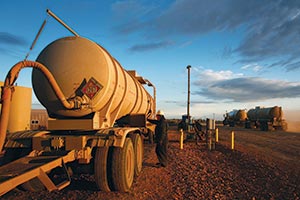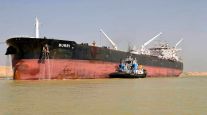Oil-Field Transportation Sector Requires Specialized Trucks, Versatile Drivers

This story appears in the Nov. 21 print edition of Transport Topics.
Trucks used in oil and gas fields are a breed apart from highway trucks, and the drivers who operate them need additional skills beyond those required of over-the-road truckers, executives in this sector said.
Oil-field trucking involves gaining access to wells that can be miles away from highways. It may mean hauling crude oil in a tank truck, or hauling in and then assembling the rig that drills the well and pumps out the oil. This category of trucking also includes transporting the water used in hydraulic fracturing, or “fracking,” into and out of a well area, or hauling in and installing test equipment.
Drivers must be able to handle a heavy vehicle in difficult, muddy terrain without abusing the clutch, and many also use winches to move heavy loads on and off trailers.
Complete Energy Services in Fairmont, West Virginia, transports oil and natural gas drilling rigs, a huge task both in terms of loading and transporting and in terms of service, as the rigs must be disassembled, moved and then reassembled by the drivers.
“What we do is like solving a puzzle,” said Shawn Black, vice president at the company, which operates 25 trucks. “You tear the rig down, load it onto the truck for hauling, move it to the next ‘pad’ or drilling site and reassemble the rig,” he said, noting the process can take four to five days. “The last rig we moved constituted 121 truckloads, and we moved it just 50 miles.”
Drilling of the Marcellus Shale in nearby southwest Pennsylvania generates as much as 85% of the company’s loads.
Cargo weights typically range from 80,000 to 110,000 pounds and may reach 130,000 pounds. About 60% of the items the company hauls are oversize or overweight loads. Large drilling rigs frequently require 80 to 110 loads to transport.
As for the company’s drivers, they “earn a lot more than typical over-the-road drivers” and are paid based on hours, not miles, Black said. “We pay about 75% more than any other industry, with some making right at $100,000 per year, though they do need to work a lot of overtime,” Black said.
Their challenges include being able to operate heavy equipment and maneuver big loads through urban areas, and, in West Virginia, “up and down steep hills,” he added.
In addition, a driver may need to operate a log skidder — a device with very large rubber tires — to haul a piece of heavy equipment up a steep mountain grade, Black said, noting bulldozers may be used at times. They also need to carry $1 million in cargo insurance and $10 million in liability.
At firms that mostly rent equipment to drilling companies, drivers may need to know how to load and unload tanks transported on flatbed trailers or do minor repairs on pumps that power tank systems.
Ron Hudash is branch operations manager at BakerCorp’s largest branch facility, in Swedesboro, New Jersey. The company rents many kinds of equipment for use in environmental clean-up and began in the oil fields in California. The company, which has 55 locations nationally, rents equipment such as frac tanks, which are used to carry fracking liquids used in oil and gas drilling, he said.
BakerCorp operates all of its own trucks, and its drivers deliver and set up the equipment, he said. In every case, this is a service business in which the drivers need to do much more than deliver cargo to a customer’s facility, Hudash said.
For example, the drivers must be able to handle tasks such as installing containment berms under tanks to catch drips, making leak-free connections between tanks and hooking up various kinds of test equipment and high-volume pumps that may be used on pipelines that haul crude oil or gas away from the wells, he said. Tasks often include loading and unloading tanks from specialized trailers that have hydraulic winches and special tank-handling equipment.
Drivers also must have “a particularly even temperament” because customers frequently need Baker’s equipment just after an unplanned event, such as a spill, and are often upset, Hudash added.
Meanwhile, equipment mainstays in this industry are specialized trailers with rollers and the hydraulic winches used in loading and unloading tanks and other items, such as multiperson portable lavatories. Another is heavy-duty tractors of various kinds with powerful hydraulically driven winch systems.
As for some maintenance items, such as engine oil changes, intervals are based on hours, not miles, because of heavy power take-off usage, Black and Hudash said. Complete Energy’s comes in at 250 hours. Complete Energy also applies high-quality synthetic grease to its trailers at frequent, hourly intervals, Black said. Hudash said BakerCorp’s technicians work mostly on the company’s many types of pumps and leave all but simple maintenance such as oil changes and running light replacements to nearby shops.
Finally, as with any fleet, one critical issue is driver management.
Black said his fleet always needs to hire drivers “with a decent amount of experience.” Many are veteran owner-operators and have previous experience operating heavy equipment, he said.
To streamline its processes, Baker- Corp has been implementing its “rent-ready optimization concept,” a program designed to reduce the time needed to make returned equipment ready for the next renter.
That program exists to improve customers’ experiences, Hudash said. “Fortunately, the drivers and other workers bought in early.”
For drivers, this has meant close attention to their pre-trip inspections. A detailed paper form is used now, but that will be replaced by an electronic driver-vehicle inspection report soon. Items that need repair are color coded to ensure priority handling.
BakerCorp’s Swedesboro facility incorporates a conference table along with displays that show active job progress.
“The display gets the drivers more involved in what is happening and especially how the company is doing safety-wise,” Hudash said.




